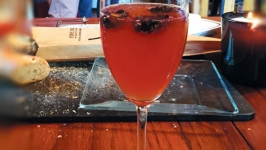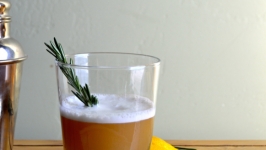Absinthe Makes the Heart Grow Fonder
Belle Époque France and neighboring parts of Europe became enthralled with a concoction of wormwood, fennel, wild marjoram, and aniseed, which made a potent liqueur nicknamed the “Green Fairy” for its seductiveness. The Latin name of its key ingredient, wormwood (Artemisia absinthium), also a folk remedy, honored the Greek moon goddess: mistress of the chase and paragon of chastity.
To most people nowadays, the drink connotes brothels and decadence, laggards and libertines, outliers like Oscar Wilde and Vincent van Gogh, who were both rather fond of it. No wonder the “emerald-tinted poison” quickly made inroads with the Klondike crowd. In 1902, McDonald’s Saloon in Dawson City — owned by the liquor and cigar merchant Simon McDonald — stocked cases of it.
Forever haunted by deadlines and writer’s block, scribes succumbed to the distillate’s spell.
The sourdough-poet Robert Service did finish his Ballads of a Bohemian in a Paris attic, where he’d moved after the Klondike frenzy. Jack London, however, who preferred martinis anyway, guzzled it “seemingly without enthusiasm,” according to one historian. “The trouble with the stuff,” London wrote, “was that I had to take such inordinate quantities in order to feel the slightest effect.” It must have been weak, inferior product, or else the writer — who boozed himself into an early grave — had acquired some tolerance.
The craze surrounding this licorice-flavored aperitif soon spread beyond artists, misfits, “good time girls,” and expatriates. Its preparation and paraphernalia are still part of the appeal, much like loading a pipe with tobacco or brewing a cup of tea. The liqueur is poured into a stemmed glass with a “reservoir” bulge used to measure out the correct amount. Then it is diluted with ice-cold water, which is drizzled over a sugar cube that sits on an ornate, slotted silver spoon, straddling the glass. The infusion turns the liquid milky pale, like your typical anisette.
Late nineteenth-century reports of absinthe-induced hallucinations and madness could not be verified, even then. France’s banning of the beverage on the eve of WWI had more to do with morality, patriotic fervor, and the fact that the 90 to 148 proof elixir put large segments of the populace out of commission.
Thanks to the Port Chilkoot Distillery in Haines, Alaskans can partake in a local version of this bottled mystique — the real thing, not some sugary knockoff with artificial colorants. Known for spirits with a unique sense of place, for marine-themed gin, whiskies, and vodka, the owner-operators Sean Copeland and Heather Shade dare you to surrender to the mermaid.
They painstakingly handcraft their Green Siren Absinthe based on a recipe from the 1700s, soaking it twice with their fragrant house mélange of locally grown herbs: lemon balm, anise hyssop, and, of course, wormwood. Connoisseurs less bound by tradition can heed the femme fatale’s call by mixing absinthe into cocktails, or by chilling it “on the rocks.” Imbibing ship captains should take care not to get wrecked on those.






